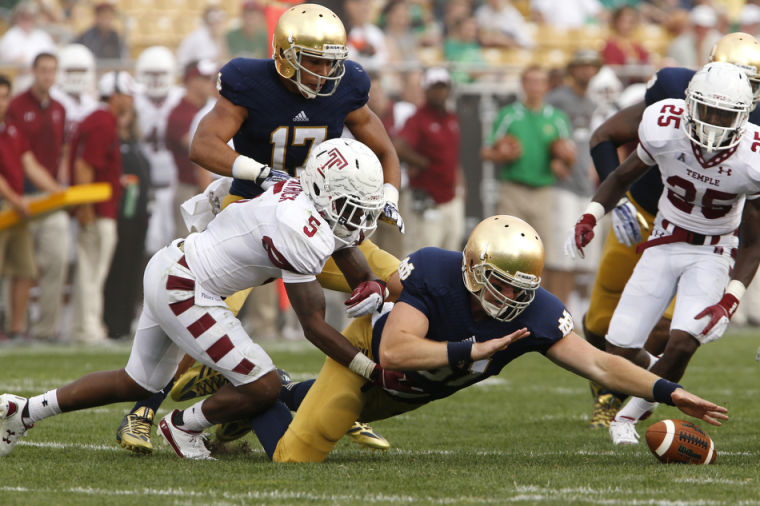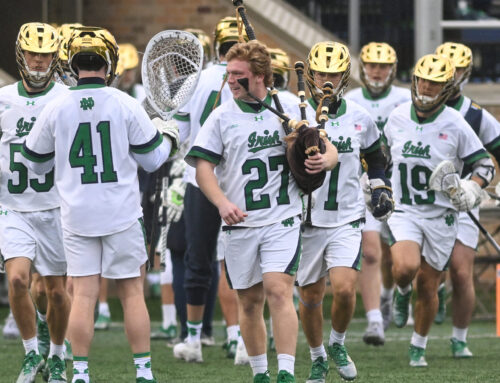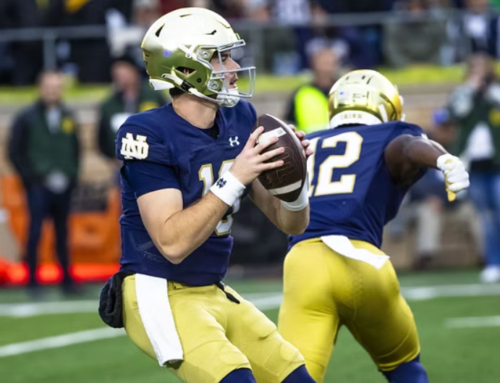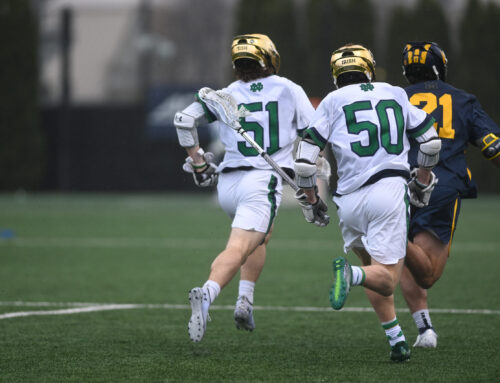Recapping Notre Dame –Temple with advanced stats: a dominant rushing performance, some questions in the passing game, and an improving defense that showed flashes but needs more consistency.
Introduction
If you’ve been with us a few years, you’ll notice a few tweaks and changes for 2017. I’ll introduce them as they arrive, but as always much credit to Bill Connelly (who invented the majority of these stats). If confused, check out the advanced stats glossary here.
The Basics

With the majority of our advanced stats we’ll discount garbage time unless otherwise noted. There’s no consensus on defining when it’s truly garbage time – it’s usually a lead of about three-four scores in the 1st half, and 14-17 points in the second. Since we’re watching all the games (I assume), I’m usually subjective with identifying when garbage time begins.
For all the talk about a more up-tempo offense, the Irish wound up with a pretty average pace in this one. Some of that may be Chip Long holding some cards in his Under Armour sleeves for UGA, some of it may have been the game situation with the Irish up by a lot early, but it’s worth keeping an eye on as the season progresses. The idea of tempo has been a perennial offseason talking point that is gone by late September, but if Long really has the keys now, we should see a difference.
There’s typically an inflection point where you can see the strategies of both teams change with desperation and goals of running out (or preserving) the clock taking priority. On Saturday that was with 1:22 left in the 3rd quarter, when a fifth ND touchdown put the Irish up 35-10. 29% of the games plays were then conducted in garbage time, and have mostly been filtered out from the numbers below.
Explosiveness

Some housekeeping first – in addition to comparing YPP (Yards per Play), I’ve added YPSR (yards per successful run) and YPSP (yards per successful pass) to measure explosiveness. These should help answer the same question IsoPPP, the explosiveness component in S&P+, attempts to – when you’re successful, how successful are you? But unlike IsoPPP, which assigns a value to yardage in different parts of the field, we’ll keep this simpler with just the average yards per successful play. I’ve also added two defensive stats – havoc rate and stuff rate – to capture a versions of “explosion” for the defense in addition to big-play prevention.
It’s tempting after Saturday to wave aside Notre Dame’s video-game numbers with a condescending “Well, Temple”. But this is a defending conference champion (in the 6th best conference) that hired an excellent DC as its new head coach. Yeah, there’s turnover and a big talent advantage, but this is a team project to be around the same quality as Maryland, Minnesota, Arizona State, and host of other major conference teams. Demolishing them on offense in this fashion is very, very nice.
After struggling last season to break long runs, rushing explosion appears to be back in a big way. While the game was still competitive, the Irish hit an explosive play (run of 12+ yards or pass of 16+) on almost a quarter of their plays. The passing offense hit a few longer passes to Equanimeous St. Brown and barely missed a few more, while still keeping things relatively vanilla. There’s not cause for concern yet, but a second viable receiving threat is in shadowy “a challenger may or may not be approaching” territory right now.
Mike Elko’s philosophy is much more “bend but don’t break” than Brian Van Gorder’s, and we saw that executed fairly well against the Owls. There were just three gains of 20 yards or more for Temple before garbage time, and while some of the missed stops were frustrating, the Irish forced an inferior opponent with an inexperienced QB to attempt to string together many successful conversions.
That “bend but don’t break” tilt also doesn’t mean the defense wasn’t disruptive. After tallying a havoc rate (% of pass deflections, TFL, and forced fumbles) of just 13.4% in 2015 (102nd nationally), the Irish put up a strong 19.4% against Temple. 11 tackles for a loss helped, forcing multiple passing downs where the defense mostly took advantage and forced stops.
Efficiency

There aren’t many surprises here – the Irish rushing attack was ultra-efficient, while the defense was inconsistent and capitalized on a shaky Temple passing offense. As Eric pointed out in his recap, the Notre Dame run defense yielded a lot of successes early but tightened up substantially in the second half. The Owls averaged 4.9 yards per carry on their first eight rushing attempts on first down, then the Irish stuffed their last four before garbage time for total of -6 yards. There’s your “I need a drink” and “start drinking the kool aid” moments getting ready for UGA in two small stretches.

If there’s an area for concern on offense, it’s if Notre Dame can pass the ball when everyone knows it’s coming. The Irish converted just four of sixteen passing downs (2nd and 8+, 3rd and 5+ – not necessarily passes, but scenarios where passing is the likely course of action). Brandon Wimbush faced six 3rd and longs of 7+ yards, which included his early touchdown scramble. But in the other five attempts he was 1-5 for 4 yards and the costly interception.
The receivers will have to help for passing efficiency to improve, and outside of St. Brown there weren’t a lot of answers in week one. Cam Smith seemed to be the second target at receiver, but was only able to turn five targets into 10 yards. The tight ends received 12 of Wimbush’s 30 targets and were efficient options but Alize Mack had some costly drops and miscommunications. Kevin Stepherson would provide a much-needed threat, but he doesn’t seem destined to return any time soon.
Defensively the Irish did a nice job with the leverage battle and forcing Temple into passing downs (granted, some was the Owls to themselves with penalties). Once in those passing downs the Irish were just ok against a pedestrian offense – the screens given up and some poor tackling were reminders that Mike Elko is not a wizard and this will not become a good defense overnight.
Scoring Opportunities, Field Position, and Turnovers

It’s tough to complain much about converting scoring opportunities when Notre Dame converted every red zone visit into a touchdown. The Irish weren’t perfect with scoring opportunities, but Justin Yoon’s missed field goals weren’t by much. I appreciated BK’s call to go for it on 4th and 2 at the Temple 41 in the fourth quarter, but it was a little underwhelming with a vanilla run by Tony Jones stuffed after an incompletion on third down.
The field position battle was fairly even in this one – both teams received their best starting points off turnovers, but generally special teams were solid and unspectacular. The Irish started on average at their own 27 while Temple started at their 31. The Tyler Newsome / Julian Love combination was lethal, but kickoff coverage was a little lackadaisical.
Turnovers were even – the Irish recovered the only forced fumble of the game, and the Owls were able to snag one of a few Wimbush throws into tight windows. Both teams were only able to get their hands on a few pass deflections, and Notre Dame got a bit lucky that Tony Jones was barely down before losing the ball on a third quarter run.
On to Georgia
Three things to watch for on Saturday in a huge game against the Bulldogs:
Leverage rate
Leverage rate is the percentage of plays that are standard downs (versus passing downs). How often are the UGA and Notre Dame offenses forced into passing downs and third and long situations? How will they perform on these downs? The Bulldogs ranked 80th in Passing Downs S&P+ in 2016, and there’s no reason to believe that will improve with a freshman quarterback making his first start on the road. Mike Elko’s Wake Forest defense also ranked 21st on Passing Down S&P+ defense last year, and I think he probably has some fun wrinkles up his sleeve for Saturday night.
The Irish defense forcing so many stuffs against Temple is a great sign looking toward a shaky Georgia line, but tackling wasn’t consistent and the level of competition goes several steps up against Nick Chubb and Sony Michel. If Georgia is in a lot of 3rd and 4 yards or less situations, it’s going to be a long day. The ND offense as a whole will also face their biggest challenges of the early season trying to block of huge, talented, and athletic front that was 29th in Passing S&P+ last year and brings almost everyone back.
Both quarterbacks will be susceptible to mistakes on third and long, and this is where Fromm and Wimbush will try to avoid beating themselves. Both made more than a couple ill-advised throws in their openers, and will need to prevent turnovers that could swing a pretty even matchup (see: FSU-Bama).
Run Success Rate
Last season UGA was only 57th in rushing success rate, with the poor offensive line performance making things hard for Chubb and Michel. It seems impossible for a unit with Georgia’s talent to stay as bad as they were last year on the OL, but Notre Dame still has questions about run blocking and interior DL depth. When the home team has the ball, Georgia’s defense is stout but wasn’t penetrating last year, ranking better in limiting explosiveness (17th) than efficiency (43rd). The Bulldogs also struggled in power run situations, allowing opponents to convert 75.6% of runs on 3rd/4th and two yards or less (110th in FBS). Both defenses won’t give up many big plays, but the more consistent success the better the chances of breaking a long run (and setting up play action).
Yards per Successful Pass
Both the Irish and Bulldog defenses have serious question marks in the secondary – the Dawgs are strong at safety but have had injuries plague a couple top corners. They’ll both face challenges staying disciplined against run-first attacks that are tempting to cheat up against, especially if they’re finding success. Georgia was very good limiting big plays last season (20th in IsoPPP+), and Notre Dame prevented the big plays against Temple (thanks in part to some QB inaccuracy). I don’t expect either passing game to be very efficient on Saturday night, but the one that can break a few long gains will have the upper hand (and maybe free up some breathing room for the run game).





Excellent write up. I was pleasantly surprised at how dominant we looked at times against Temple versus previous years of somewhat slogging through games I felt like we should be in total control of. I share your concern going forward of how effective the passing game can/will be on obvious passing downs. I don’t remember if it was in another post or a comment regarding the receivers, but I also felt that something just seemed…off a little bit. Maybe they were holding back a bit for the uga game, who knows. Anyway, good to be back here and be reading the posts/comments on the site. Keep up the good work. Looking forward to Saturday!
Nice job putting metrics to the notion that ND’s trouncing of Temple was meaningful. How meaningful? Well, ND hasn’t had 9.6 YPC in a game since 1942. Seventy five years. And we’ve played far more hapless defenses in those 75 years than Temple is. ND is doing something right, something very right, in its running game.
I’m also amused watching the Georgia fanbase poo-pooing ND’s offensive stats against Temple as if it is fool’s gold. When was the last time Georgia had 422 rushing yards in a game? Forty one years ago. And in those 41 years, Georgia has played some seriously terrible teams (at least two each year with a worse defense than Temple’s). So where are all their games with a 9.6 YPC average and 422 rushing yards? No, sorry, that’s a very meaningful performance by ND.
Further, if we break down the rushing game by ND and Georgia, respectively, this last weekend, it’s even more concerning for the Georgia faithful. Taking out ND’s top three runs (among them, a 60 yarder and a 66 yard run), ND still averaged 6.6 YPC in the remaining 41 rushes. That points out that the stats weren’t moved to a misleading area code by the longer runs. Meanwhile, take out Georgia’s three longest rushes (none of them as long as ND’s, even), and their 41 remaining rushes averaged a mere 3.0 YPC. Against Appalachian State.
I think we have the better rushing attack. I think it will show up all day long against Georgia. Absent mistakes like fumbles and interceptions, ND can roll Georgia on Saturday night.
Great numbers. I think the casual UGA fan thinks our OL is overrated (and theirs will be fine) and that their backs are a significant advantage over ours. And while Chubb and Michel are both incredible, I think the edge is slight against Adams/Williams/Jones and the imagined advantage more a product of draft hype and recruiting stars than actual performance.
The casual UGa fan think that because Alabama is excellent, so are they. The embrace a weird SEC-transitivity principle.
UGa fans tend to get fixated on the Chubb/Michel highlight reel. Both uncork more than their fair share of electric runs, and I would not be surprised if we see 2-3 huge gainers. Both look fabulous in the open field. What UGa fans tend to ignore are the dozens of runs that go nowhere between the explosive plays.
This is not a Navy-type of frustration as they don’t s churn out one 5 yd run after another. We’ll probably see us make a bunch of stuffs and then they inexplicably explode for a 50 yarder. I’m not sure which is more maddening.
I live in Savannah. I haven’t run 🏃 Into many casual UGA fans.
Hopefully they are pooh-poohing the stats and not poo-pooing the stats.
What if they’re Polynesian? They could be pupuing the stats.
Some of our more dubious FPW are able to poop out stats
I’m hoping that after the game they’ll be boo-hooing the stats.
Did you give Temple too much credit in the PPD numbers? Or is this one of those situations where the advanced stat rules do something that isn’t obvious? Temple scored 16 so shouldn’t the PPD inside the 40 be 3.20, and PPD RZ 4.00?
Did you come here to play school?…But it looks like your math is right.
Good fact checking – I got on autopilot there and gave Temple credit for 7 points instead of 6. Fixed.
Thanks. It was mostly a continuing attempt to understand the advanced stats. i know there’s been a few times over the years that i’ve asked about something and the way you had it was correct, but the correct way wasn’t intuitive from my point of view. i appreciate all the mathing you do.
I keep telling you guys, math is for nerds. I actually like seeing these stats. Don’t stop putting them out.
Totally unrelated: http://www.espn.com/college-football/story/_/id/20610618/former-notre-dame-fighting-irish-player-douglas-randolph-suing-university-allegedly-concealing-mri-results
I really hope this is not true. I hate the stories how young kids are sacrificed/used for some short-term gains. Anyone know anything about this? It is slightly hard to believe because wasn’t Randolph more of a non-contributor? Hard to imagine forcing him to play (as opposed to like forcing Jaylon Smith type player to play even if it would hurt him).
I have NO knowledge about the case and minimal knowledge about law, but my understanding of tort cases is that there has to be harm to the person (either through commission or omission of action). Without the player actually suffering harm…only being subjected to an increased risk of harm…the case would have no merit and would be dropped before reaching trial. I’d also be surprised that Kelly or any of his staff would subject someone to potential paralysis if they felt that was likely based on an MRI.
He is suing for negligence, so he would have to show that (1) the university and BK owed him a duty; (2) the aforementioned breached that duty by forcing him to play; (3) this caused his injuries that (4) resulted in damages.
So basically, his claim is that, because they forced him to continue to play, he suffered further injuries which resulted in long term medical issues. (This is my understanding from one torts class 2 years ago).
It is interesting that he went through the whole 2017 season with us as an assistant and then filed. Wasn’t he the one doing the “night-night” thing when that dude from USC got knocked out and Tilley did his egregious act? (Not trying to victim blame; just found it a bit ironic).
I dont see how he could sue the UNIVERSITY for this. If the doctors told Kelly he was fine and could play, that would be on them. Why would ND be responsible for following medical advice?
I would guess its two fold:
First, he was engaged in a contractual relationship with the University, plus he was playing for the University. So, even while this is not a contractual claim, there is an inherent degree of connection between him and the University.
Two, respondeat superior, which is basically suing the employer for actions of the employee.
If an actual lawyer wants to enlighten on this topic, that might be more helpful lol. For the moment, I am still just a student and everything should be taken with a grain of salt.
If #3 is right, then you are correct, but based on the article there is no mention of actual injury. He is suing because the University risked him getting an injury. Negligence is the same thing as omission of action, but there has to be harm to sue.
Negligence can be an omission, but not necessarily. It is more generally taking action that a reasonable person would not. So if a reasonable person (likely measured on the standard of a doctor here) would have kept him off the field, then they may be liable.
Also, the law suit does allege further injury: “all subsequent injuries and permanent damage he has endured would have never occurred.” Basically, he is saying I should have never stepped foot on a football field again, and any damage that I did suffer is the result of your negligence. So he is alleging harm through injuries and permanent damage to his spinal issues.
Yeah. We’re in agreement, but I didn’t see in the article any mention of injury or damage. If he has some kind of injury, he may have a case, but the article simply mentions it as if he’s suing because the University risked him getting an injury…and he wouldn’t have played had he known that he had a risk of injury.
I posted about this in a different story on here but I read he has spinal stenosis now. I guess I’m not sure how anyone could miss a diagnosis like that previously if he in fact had it when he had his first scan. I do work in healthcare but I’m not a spine surgeon so I don’t know if this sort of thing happens. Seems crazy to me that a team doctor would look at a scan, see that there was a problem, but tell the coaches the kid is ok to keep playing. Terrible, if true.
It would cost that doctor his license if he did. ND also doesn’t have its own MRI equipment, so that would mean personnel outside the university would be involved. I mean, is it possible that somebody looked at an MRI and missed something? Sure, it happens all the time. But to suggest that the staff drove him back to the field in willful disregard of his health – the same staff that told Dan Wenger, Corey Robinson, et al. that they should hang it up – and that a doctor who is not beholden to them in any meaningful way would risk his career to assist them in that strains belief.
It’s also worth noting that Randolph’s father is an oncologist. I can’t imagine that he had no reservations about his son complaining of numbness in all four extremities and not being told what the results of the MRI were.
I’ve seen commentary from an actual attorney, not a poseur like Dmac (you know I love ya, buddy), to the effect that they may have filed the suit just to avoid the statute of limitations running out, which in Indiana is two years for a negligence claim. The suit would preserve Randolph’s ability to force the university to cover insurance costs, pending its outcome. As they say, it’s not personal, it’s just business.
I didn’t realize his dad is a doctor. That certainly changes my appraisal of the situation. If my kid were complaining of numbness in all extremities after an injury, I wouldn’t let them send him back on the field. Of course, I probably wouldn’t let my kid play football, so….
Yeah. His mother is a dentist, btw – as Stu from The Hangover can attest, “not a real doctor” but familiar with how things work in medicine at least. The one caveat there is that we don’t know how much his parents knew about what was going on – I certainly didn’t tell my parents everything back then, and if I thought it might take away an activity I loved I’d probably be even more reticent. At the same time, the symptoms he describes are pretty serious, and if I had something going on like that I’m pretty sure I would’ve talked to them about it.
But all that’s hypothetical. We don’t know how much they knew about anything.
One note on tempo – it definitely only made a couple of appearances on Saturday, but at least one those appearances was a doozie. On Notre Dame’s opening drive, just 16 seconds elapsed from the time Equanimeous St. Brown stepped out of bounds to the time the ball was snapped for Josh Adams’s big run.
Good call. Also worth noting that UGA (typically pretty average in tempo) will speed things up if they’re stringing a few successful plays together – they did this vs App State when Fromm completed his first couple passes in a row.. They may also go this route if we’re trying to sub a lot like we were against Temple and they get a DL rotation they like (keep our freshman on the field, for example)
That worries me. I’ll like to see how Elko deals with tempo.